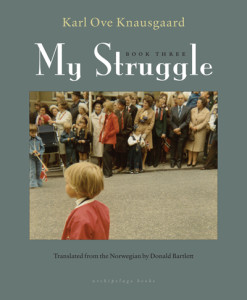Just seeing the word introvert threw me into despair.
Was I an introvert?
Wasn’t I?
Didn’t I cry more than I laughed? Didn’t I spend all my time reading in my room?
That was introverted behavior, wasn’t it?
Introvert, introvert, I didn’t want to be an introvert.
That was the last thing I wanted to be, there could nothing worse.
But I was an introvert, and the insight grew like a kind of mental cancer within me.
Kenny Dalglish kept himself to himself.
Oh, so did I! But I didn’t want that. I wanted to be an extrovert! An extrovert!
 This passage comes at page 336 (of 420-some) of the third volume of Knausgaard’s My Struggle, after he reads about the key difference between Dalglish and his Liverpool soccer teammate Kevin Keegan. It’s simply great, the passage. One concern my NF students have is how to write from the perspective of our younger selves. Are you allowed to use words you wouldn’t have used when you were 7? If no: how do you make the experience interesting and insightful? If yes: how do you make it feel authentic and not as though you’re now, as an author, giving your young self big ideas you never had?
This passage comes at page 336 (of 420-some) of the third volume of Knausgaard’s My Struggle, after he reads about the key difference between Dalglish and his Liverpool soccer teammate Kevin Keegan. It’s simply great, the passage. One concern my NF students have is how to write from the perspective of our younger selves. Are you allowed to use words you wouldn’t have used when you were 7? If no: how do you make the experience interesting and insightful? If yes: how do you make it feel authentic and not as though you’re now, as an author, giving your young self big ideas you never had?
This passage is great for the way it shows us how. Knausgaard gives the writing a childish syntax (the short sentences, the single-sentence paragraphs, the repetition) while allowing himself an adult diction (the “mental cancer” bit) that can put the passage into a greater perspective. In other words, the syntax lets us hear and feel his despair, and the diction tells us something of what that experience was like or what it meant.
It ends a section, this passage.
Here’s one more, even later in the book. Young Karl Ove has begun noticing girls. Also, he’s read all the fiction in his school library and starts looking at history books for a school project:
I took out a history book and sat at the desk under the window. Outside, it was misty but warm. The playground was deserted. I flicked through the book and looked at the pictures.
Suddenly I saw one of a naked woman. She was so thin her hips protruded like bowls. All her ribs were visible. Between her legs there was a small, black tuft. Behind her there were rows of bunk beds in which I glimpsed other female figures.
My insides shook.
The passage continues to describe other nearby photos with piles of corpses and bodies that were only collections of their parts. Nowhere is the word “holocaust” or “concentration camp” used. Naturally. Because this is Karl Ove’s first encounter with the holocaust, and it comes from the excitement of a pubescent boy’s libido. A naked woman! Without any knowledge of the context of the picture, all he has to go by is the forms of stimulation the image works on his body. As he says later, “there was nothing attractive about her, although she was naked.”
That his insides shake is a pretty great way of getting at what this confusion must’ve felt like.
Some nakedness is not arousing, is the lesson we all have learned by now. But he is learning it at this moment. How vital it is not to name the holocaust here! To keep that explanation from us readers. It’s not just show-don’t-tell. It’s honoring the power of that original experience by not letting it get discussed by the narrator-self.
I say it a lot in classes, because it’s easy to forget: more often than not, your narrator has to shut the hell up.